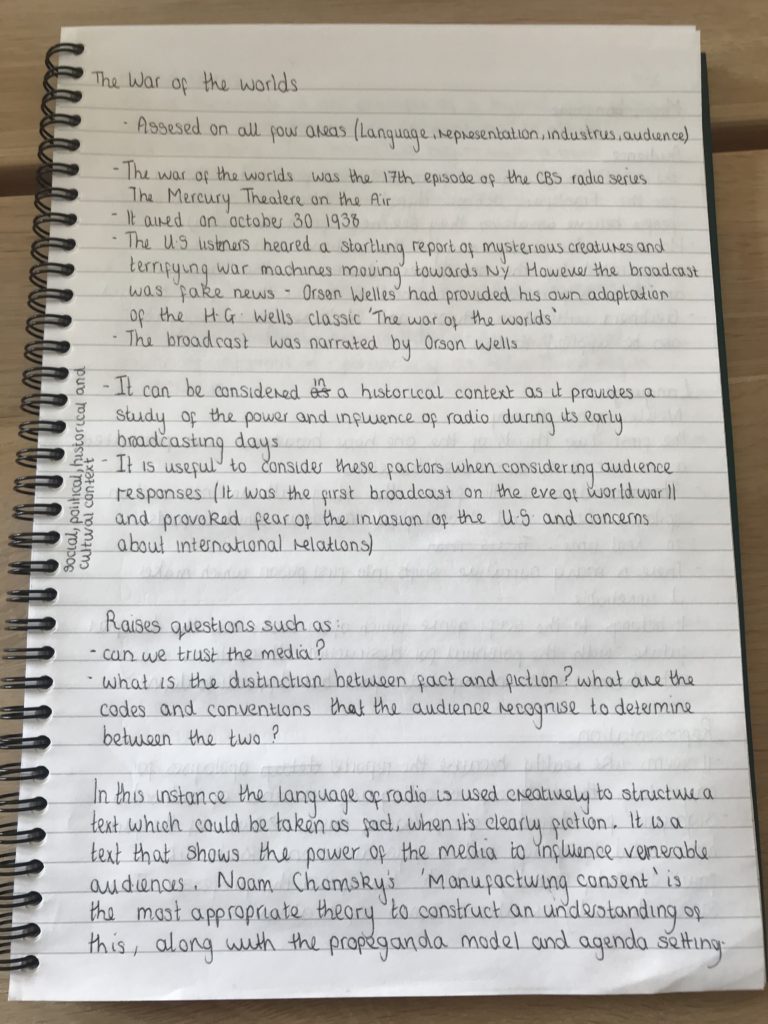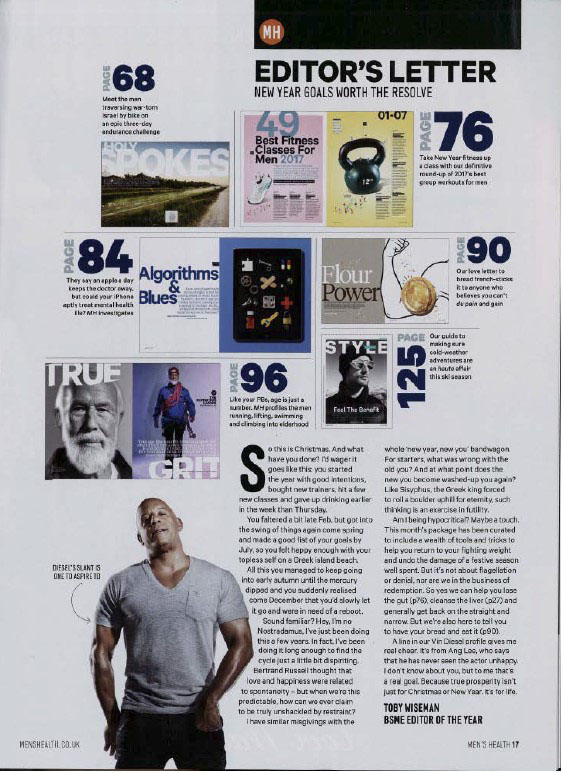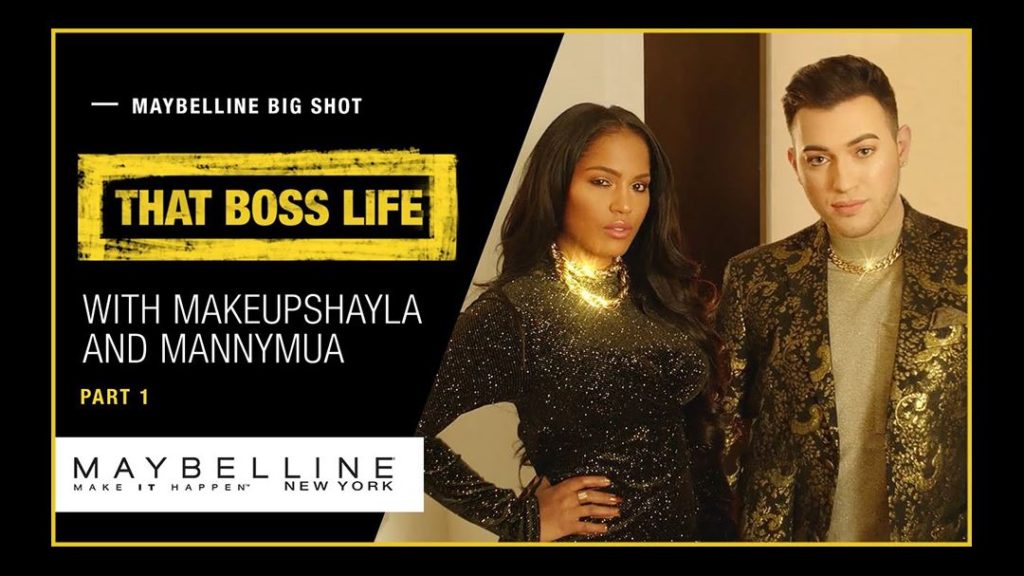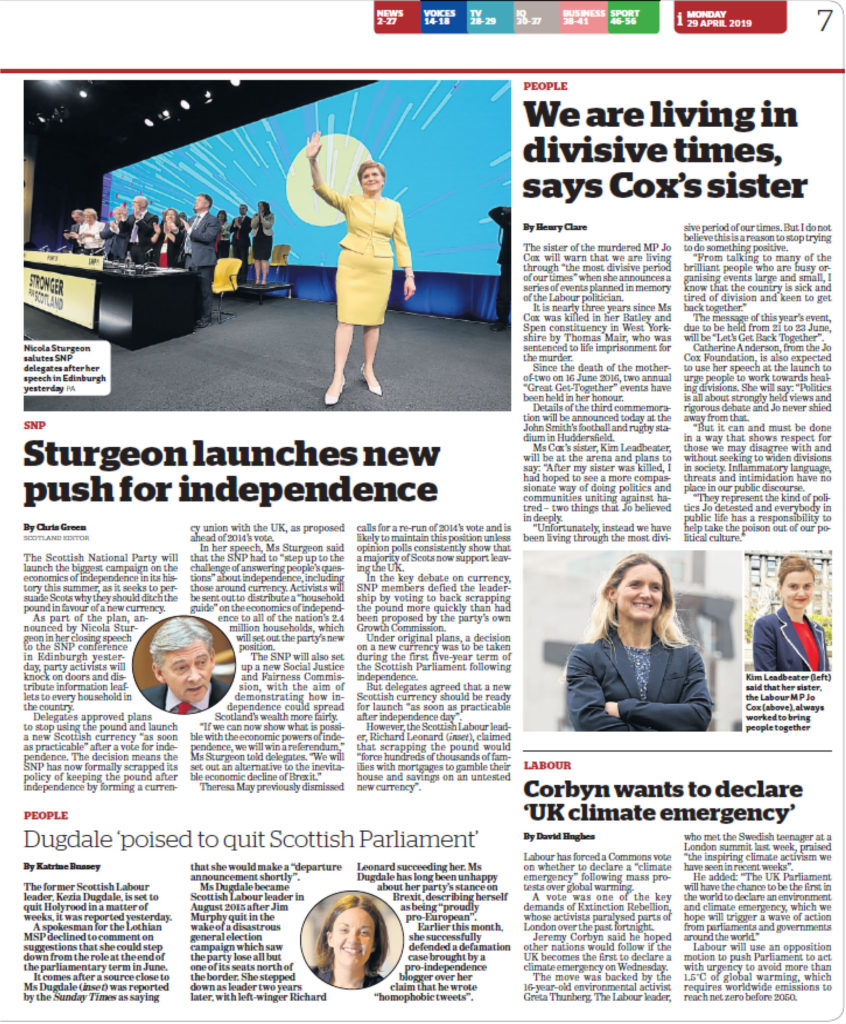







“The War of the Worlds” is an episode of the American radio drama anthology series The Mercury Theatre on the Air, directed and narrated by Orson Welles
It was broadcasted live as a halloween special at 8pm on Sunday 30 October 1938 by CBS Radio.
The radio episode became famous after brining listeners into panic due to a range of realistic live reports about a supposed alien invasion, this radio drama may have been the start of fake news.
To what extent is The War of the Worlds a historically significant media product?
I believe that to a great extent, The War of the Worlds is a historically significant media product in many ways.
War of the Worlds is an early example of a hybrid radio form, adapting the H.G Wells story using news and documentary conventions. Also, it is known as an episode of the American radio drama anthology series The Mercury Theatre on the Air: providing a strong brand identity.
The broadcast and the initial response believed that this was an early example of a documented mass media, having a direct effect on the audience’s behavior. It became famous for causing lots of panic from the audience and the immediate aftermath was chaotic. It was said that the studio was invaded by policemen and in some places, mobs were in the streets. Plus, there were many calls reporting deaths. Additionally, a study by the Radio Project discovered that fewer than one-third of frightened listeners thought the invaders were aliens. However, most people thought they were listening to reports of a German invasion or a natural catastrophe.
The radio broadcast was aired over the Columbia Broadcasting System radio network, showing the power of networking, and within three weeks, newspapers had published at least 12,500 articles about the broadcast and its impact. Furthermore, Adolf Hitler referenced the broadcast in a speech in Munich on November 8, 1938. This would have brought even more attention, making it more of a historically significant event.
The more attention the situation gets, the more history it has. So, therefore, I believe that The War of the Worlds had a big impact historically, as it had a large impact on the society, with different reactions through Stuart Hall’s theory of preferred reading. If people viewed a situation with the same consistent dominant reading, War of the World’s most likely wouldn’t have been significantly historical as it is today. Through people having different readings, such as negotiated, dominant and oppositional, the more room for further reactions/opinions. Therefore, the War of the Worlds was a great impact, as it had numerous different reactions, causing a big impact, and therefore creating a significant historical event.
“The War of the Worlds” is a radio broadcast from 1938 adapted from the H.G. Wells book of the same name. It was broadcast during the “Golden Age” of radio when mass media was starting to take off, but it was also broadcast during a time of great tension, anxiety and panic – the great depression and the rise of dictators like Hitler and Mussolini whose power in Europe provided people with fears of a looming world war, which indicated the presence of “hard times”, and as J.McDougall states in “Fake news vs. Media Studies”: “Hard times are a breeding ground for misinformation”. Orson Welles, in making the War of the Worlds broadcast, demonstrates to listeners the power of radio – how it can be used to manipulate as in Nazi Germany, where Hitler and his propaganda minister Goebbels made exhaustive use of radio’s power as a burgeoning domestic mass media form to broadcast “news” of Nazi propaganda. On the eve of war in 1938, Orson Welles attempted to show people how untruthful and manipulative media can be, as exemplified by his quote: “we wanted people to know that they shouldn’t take any opinion predigested, and they shouldn’t swallow everything that came through the tap whether it was radio or not”. Therefore, the war of the worlds is a highly influential and significant media product, as it is a pioneer of blurring the lines between fact and fiction, subverting the audience’s expectations of the genre of sci-fi and radio dramas. The broadcast employs cultivation theory by using the codes and conventions of genuine news reports multiple times to convince the listener that what they are listening to is actually real, while also exposing, in the vein of Barthes, how the professionalism of news reports does not mean they are more truthful or trustworthy than any other information source can be.
The broadcast therefore also demonstrates how media institutions manufacture consent, linking with the ideas of Noam Chomsky, as with the broadcast of War of the Worlds Orson Welles creates a satire on how the media dominates power. By exposing how people react with panic if the “news” provides the audience with information about the atrocity of an event, he exposed how the media can spread misinformation and exposed the way the media in the United States often attempts to maintain the system and keep order.
By increasing the verisimilitude of the broadcast by only telling viewers at the start of program that it is a fictional radio drama and presenting the broadcast partly as a series of simulated news reports that interrupts supposed regular radio programming, it constructs a representation of reality through fiction. It also reflects common fears of many people at the time, of war and invasion stemming from the growing authoritarian regimes throughout Europe, and as such the aliens can represent the fear of invasion of the USA by foreign powers, but also, to link in with Chomsky’s ideas and the critique of media institutions, the aliens can also represent the way the media utilises “wars on” or anti-communism to provide an enemy that is supposedly a threat to society in order to control the people. With this the audience can become far more immersed, as the use of radio allows the listener’s imagination to fill the visual gap with real life analogies. This is perhaps why many people supposedly took the broadcast as fact, not just due to its imitation of real news reports but also the wider social and political contexts the product exists in, which increases the verisimilitude of the product.
Overall, The War of the worlds is a very significant media product because it pioneered the use of verisimilitude and the subversion of traditional ideas of genre to critique the mass media institutions, but also to demonstrate to people and institutions how powerful radio can be, by showing how fake news can be interpreted as reality by undiscerning audiences.
Section A
CSP 1 – Tomb Raider




Front Cover –
Back Cover –
Context –
CSP 2 – Mens Health



The men’s health magazine uses a positive stereotype of men that has been used in order to convey the idea that the main subject is strong and independent, sexualisatione is limited. This appeals to the audience as it suggests they will be able to appear the same as the magazines dominant signifier for this issue, Vin Diesel, after purchase.
Print terms applied –
Reactionary –
Radical –
Front Cover –
Short + snappy play on words, # can be seen as a more female related term/ icon.
Contents Page –
Targets peoples overall appearance and intelligence, seems to be targeted specifically at a male dominated audience.
Article Page –
All positives, supporting exercise and healthy regimes.
CSP 3 – That Boss Life Advert

Icons/ Influencers – MakeupByShayla + Manny Mua
Setting: New York – This city is an aspirational way of living, sets up desire for the audience. Supports ideas of Wealth as NYC is very modern.
The Bell Boy – His narrative can be seen to be ‘on trend with gender politics’ as he represents someone from outside the beauty influencing community. But yet still has an interest in the product which opposes classic male stereotypes
Golden Suitcase – An inter-textual reference (anchorage) to other media products like slumdog millionaire. Indexial sign to the actual product (mascara) and wealth due to the connotations of the colour gold.
Throwing Mascara – Common idea of an abundance, most often paper money, the large quantity of the product adds on hyperbolic idea of luxury by comparing it to that of an abundance of cash.
Close-up – Against male gender stereotype, slow motion to emphasize product + transition (before/ after) buildup.
Colour – GOLD – After the product is applied everything becomes more glamorous, builds audience desire, even the peopled personalities change – now more confident, direct mode of address used by staring at the camera, breaking the fourth wall = builds relationship and trust.
Theorists to apply – David Gauntlett (Gender Fluidity)
Section B
CSP 4 – The Killing
Characters –
Theorists to use –
Narrative –
Themes –
Representations –
Technical Codes –
Context –
CSP 5 – Hidden Figures
The First Poster – All three of the female leads are seen striding towards the camera, confident and fearless, a NASA symbol underneath them – could be a metaphor for their intelligence/ them standing up against gender and racial stereotypes.
CSP 6 – Letter to the Free
About Common –
Music Video –
The Song –
Vivendi = Mass media conglomerate in Paris, the company has activities in music, TV, Film and Video Games.
Vivendi Subsidiaries = UMG, Daily Motion
Section C
CSP 7 – Teen Vogue
Key Words –
Industrial Context –
Audience –
Vogue/ Teen Vogue –
Teen Vogue Income Sources –
Teen Vogue offers its audience different ways to access the product, such as on Facebook, Twitter, their Website and YouTube, so it has multiple income sources. An income will be generated by the sale of advertising space.
Media Language, genre and narrative –
CSP 8 – The I Newspaper



Distribution –
Consumption –
Noam Chomsky – Manufacturing Consent
Curran and Seaton
Curran and Seaton present the view that a free press relies on a free market where individual newspapers can compete through their political stances and points of view/ success.
Free press –
Freedom of the Press or freedom of media is the principle that communication and expression through various media, including printed and electronic media, especially published materials, should be considered a right to be exercised freely
Free Market –
The free market is an economic system based on supply and demand with little or no government control… Free markets are characterized by a spontaneous and decentralized order of arrangements through which individuals make economic decisions.
CSP9 – War Of The Worlds
I’ve always said you can’t understand the world without the media nor the media without the world
Professor Natalie Fenton, quoted in Fake news vs Media Studies
War of the worlds is a key example of fake news (propaganda)
War of the Worlds, a science-fiction novel by author HG(Herbert George) Wells, was first published in 1898. It is a story of alien invasion and war between mankind and an extra-terrestrial race from Mars.
(be spectical about what is on line about the radio broadcast)
orson wells
In 1938, the world was on edge as Germany mobilised to invade Europe and populations feared gas attacks from another world war. In the weeks leading up to the 1938 broadcast, American radio stations had increasingly cut into scheduled programming to bring news updates from Europe on the chances of war. This meant Welles’s use of radio news conventions had more of an impact on listeners who were unaware that it was a fictional radio play.
The novel is the first-person narrative of both an unnamed protagonist in Surrey and of his younger brother in London as southern England is invaded by Martians. The novel is one of the most commented-on works in the science fiction canon
The War of the Worlds has been both popular (having never been out of print) and influential, spawning half a dozen feature films, radio dramas, a record album, various comic book adaptations, a number of television series, and sequels or parallel stories by other authors. It was most memorably dramatised in a 1938 radio programme that allegedly caused public panic among listeners who did not know the Martian invasion was fiction.
he novel has even influenced the work of scientists, notably Robert H. Goddard, who, inspired by the book, invented both the liquid fuelled rocketand multistage rocket, which resulted in the Apollo 11 Moon landing 71 years later
it was a halloween special
stanley Cohen links with “moral panics”
fake devils and moral panics
he talks about that every time there is something new that’s bad blame the media
development of radio
fake media vs media studies
32 million people listening to that broadcast
Andrew crissell wrote a book about understanding radio. learning the languages of different media forms
“radio is a blind media”- crissell
“Ive always said you can’t understand the world without the media nor the media without the world”-Professor Natalie Fenton, quoted in Fake news vs Media Studies J. McDougall p.17 2019, Palgrave)
this csp tells us more about the meaning behind the idea
For many, the wider social, political, historical and cultural contexts are not just clearly connected to media studies but they are in some ways more important.
This is the last CSP and again features in SECTION 3, assessed by a long form answer to a broad question which will look to assess knowledge and understanding around all four elements of the Theoretical Framework (Language, Representation, Industries, Audience) although most likely the focus will be on Audience, Language (ie the Language of Radio) and technology.
he argues that fake news is nothing new and is a good thing to think about when talking about this csp (McDougall)
a great example of fake news or proper gander is war of the worlds
hard times are a breading ground for misinformation
The broadcast was set out to mimic a real radio news broadcast however, before the broadcast started there was a disclaimer informing listeners that it was a performance of H G Wells’ war of the worlds novel. Although for people who may have switched radio stations to the broadcast midway through will have been confused and believed that it was a real broadcast. Radio was a relatively new type of media at the time and people were still learning about what its effects were on the public. Many argue that this broadcast was the birth of fake news as it caused panic in some parts of the United States as members of the public were calling their local authorities to ask for confirmation of the news that had heard on the broadcast. However, the panic that the broadcast was believed to have created is also believed to be a myth.
Radio is an old media format that started commercially in 1900. Around this time WW1 was about to start as tension grew.
War of the Worlds began just after the: 1930 great depression, nazi uprising, rising of Stalin, rising of Mussolini.
Andrew Crissell wrote a book called “Understanding Radio”. He says that “radio is a blind media”, so we have to imagine an image in our heads.
Fake news is not new however War of the Worlds was fake news. J. McDougall says “hard times are a breeding ground for misinformation” which basically says fake news is more accepted and spreads faster in hard times.
Stanley Cohen wrote a book called “Folk Devils & Moral Panics”. He said that ‘moral panics’ were all caused by the media.
War of the Worlds can be considered in a historical context as it provides an interesting study of the power and influence of radio as a form during its early days of broadcasting. It is also useful to consider the product in a social, cultural and political context when considering audience responses to the programme. It was first broadcast on the eve of World War II and reflected fears of invasion in the US and concerns about international relations.
“I’ve always said you can’t understand the world without the media nor the media without the world” (Professor Natalie Fenton, quoted in Fake news vs Media Studies J. McDougall p.17 2019, Palgrave)
Andrew Crissell – ‘Understanding Radio’ book.
Quote – ‘Radio is a blind medium’
Context – During the time war of the worlds was released (1930s) events such as the great depression and WW2 had occured. In addition, leaders such as Hitler and Stalin were also in power. Therefore when the radio host refer to ‘alien’ he could be refering to one of these political factors rather than actual aliens.
J.McDougall – ‘Hard times are a breeding ground for misinformation’
J.McDougall – ‘There are always points historically where populations have been discontented or economic harships have been exacerbated.
War of the worlds is a key example of fake news (propaganda)
Stanley Cohen – Wrote a book called ‘Folk Devils and Moral Panic’ – Did masses amounts of people actually panic or was the amount of paic fake news?
Same paradigm now and 100+ years ago
Orsen Welles – ‘People shouldn’t Swallow everything that came through the tap whether it was radio or not’
J.McDougall – ‘CBS cast a disclaimer prior to the narrative starting, stating clearly that this would be fiction’
J.McDougall – ‘The mediation of the panic is amplified and reactivated a much-exaggerated version of the real issue’
Board Quotes –
‘Contemporary ideas of Fake News‘
‘ fact and fiction is often blurred and relies upon audience members recognising and understanding specific codes and conventions that relate to each Media Language.’
‘ Recognising the particular social and historical moment that this media text was produced is significant, so was this a comment on the ability of the mass media to create propaganda and manipulate a compliant and vulnerable mass audience’
section c 30% overall exam andrew crissell understanding radio: ‘radio is a blind medium= you cant see it (you have images and pictures in your head).
war of the worlds may seem to be about aliens but it is not it may be about communist Europe fascist Russia.
‘hard times are a breeding ground for misinformation’ (j.mcdougall)
1. Anxious era
The broadcast tapped into the anxiety of the time. Just ahead of World War II, much of the world was nearly — or already — at war when the program aired.
“The War of the Worlds” was the 17th episode of the CBS Radio series The Mercury Theatre on the Air, which was broadcast at 8 pm ET on Sunday, October 30, 1938.
directed and narrated by actor and future filmmaker Orson Welles as an adaptation of H. G. Wells’s novel The War of the Worlds (1898).
It was performed and broadcast live as a Halloween episode at 8 p.m. on Sunday, October 30, 1938, over the Columbia Broadcasting System radio network. The episode became famous for allegedly causing panic among its listening audience, though the scale of that panic is disputed, as the program had relatively few listeners
early exampke of hybrid radio film. (stephen neale)
suspending disbelief
(stanley cohen) folk devil& ‘moral panics ‘
In this instance, the Language of Radio is used creatively to structure a text that could be taken as fact, but is clearly fiction.
j.mcdougall: The conventions of news reports were adapted for dramatic realism so for the audience to suspend disbelief and engage in the plot as though it was subject to radio journalism